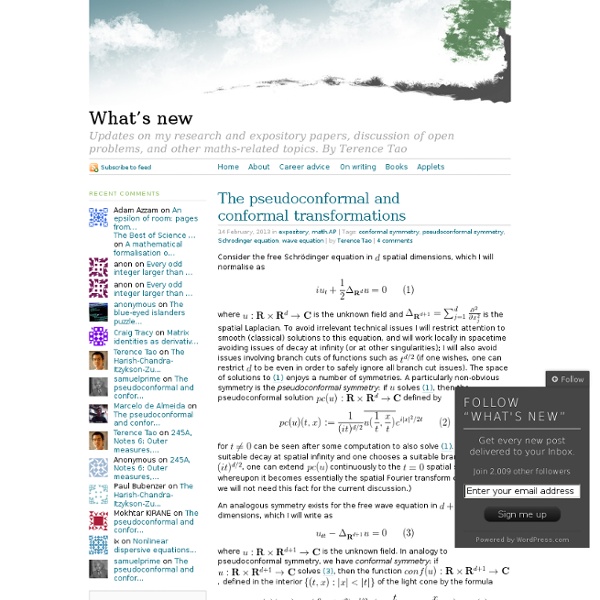



The polymath blog It's Okay To Be Smart geometry - Is this Batman equation for real? advice John Baez March 25, 2007 I have reached the stage where young mathematicians and physicists sometimes ask me for advice. Here is my advice. On Keeping Your Soul The great challenge at the beginning of ones career in academia is to get tenure at a decent university. The great thing about tenure is that it means your research can be driven by your actual interests instead of the ever-changing winds of fashion. To do this, you have to make sure you never lose that raw naive curiosity that got you interested in science in the first place. In our acquisition of knowledge of the Universe (whether mathematical or otherwise) that which renovates the quest is nothing more nor less than complete innocence. So: keep playing around with all sorts of ideas, techniques and tools. But while I'm in pontification mode, let me add some more "practical" - some might even say cynical - words of advice as well. Some Practical Tips Go to the most prestigious school and work with the best possible advisor. home
FedEx Bandwidth The Unapologetic Mathematician Astronomy Picture of the Day Wortal Stefana Banacha Home Page of Stefan Banach - English version Wortal poświęcony Stefanowi Banachowi (1892 - 1945) - jednemu z największych matematyków XX wieku. W sześćdziesiątą rocznicę śmierci prof. Stefana Banacha, w dniach 24.10.2005 - 07.12.2005 Biblioteka Wydziału Matematyki, Fizyki i Informatyki Uniwersytetu Gdańskiego zaprezentowała wystawę poświęconą postaci jednego z największych matematyków XX wieku. Przedstawiamy w tym wortalu materiały, wśród nich archiwalia, zgromadzone i opracowane na tę wystawę. "Odkrycie Banacha było moim największym odkryciem naukowym." Prace Stefana Banacha Kalendarium życia Stefana Banacha Archiwalia Książki i artykuły o Stefanie Banachu m.in. kopia książki Romana Kałuży pt. Laureaci medalu i nagrody im. Ciekawe strony WWW poświęcone Stefanowi Banachowi Ciekawostki Zaproszenie do dyskusji Pod adresem znajduje się witryna systemu wiki przeznaczona na dyskusję nad wortalem poświęconym Stefanowi Banachowi. Podziękowania Autorzy strony Free counters
Catenary A hanging chain with short links forms a catenary. Freely-hanging transmission lines also form catenaries. The silk on a spider's web forming multiple elastic catenaries. In physics and geometry, a catenary[p] is the curve that an idealized hanging chain or cable assumes under its own weight when supported only at its ends. The curve has a U-like shape, superficially similar in appearance to a parabola, but it is not a parabola: it is a (scaled, rotated) graph of the hyperbolic cosine. The curve appears in the design of certain types of arches and as a cross section of the catenoid—the shape assumed by a soap film bounded by two parallel circular rings. The catenary is also called the "alysoid", "chainette",[1] or, particularly in the material sciences, "funicular".[2] Mathematically, the catenary curve is the graph of the hyperbolic cosine function. History[edit] The word catenary is derived from the Latin word catena, which means "chain". Inverted catenary arch[edit] Catenary bridges[edit]
VideoLectures - exchange ideas & share knowledge Empirical Zeal Varignon's theorem Varignon's theorem is a statement in Euclidean geometry by Pierre Varignon that was first published in 1731. It deals with the construction of a particular parallelogram (Varignon parallelogram) from an arbitrary quadrangle. The midpoints of the sides of an arbitrary quadrangle form a parallelogram. If the quadrangle is convex or reentrant, i.e. not a crossing quadrangle, then the area of the parallelogram is half as big as the area of the quadrangle. If one introduces the concept of oriented areas for n-gons, then the area equality above holds for crossed quadrangles as well.[1] The Varignon parallelogram exists even for a skew quadrilateral, and is planar whether or not the quadrilateral is planar. Special cases[edit] The Varignon parallelogram is a rhombus if and only if the two diagonals of the quadrilateral have equal length, that is, if the quadrilateral is an equidiagonal quadrilateral.[2] Proof[edit] A second proof requires less mathematical aptitude. See also[edit] Notes[edit]
Math on the Web: Mathematics by Classifications Mathematical Awareness Month Math in the Media [Monthly magazine from the AMS] AMS Feature Column [Monthly essay from the AMS] MAA Online Columns Collection [Peterson, Devlin, Colm, Bressoud, Adams and Narayan, Sandifer, Morgan, Bogomolny, Peterson, Pegg] Frequently Asked Questions (FAQ) about Mathematics (The Sci.Math FAQ Team) Favorite Mathematical Constants , by Steven Finch; An online book and extensive collection of the author's "favorite" special numbers. Simon Plouffe's Tables of Mathematical Constants to millions of decimal places. The Erdos Component Page at Oakland U (Rochester, MI USA) - Information on the graph of collaboration in mathematics (J. John Baez's "This week's finds in mathematical physics" Math for Poets, Understanding Mathematics, and Gödel, Escher, Bach (J. International Congress of Mathematicians -- ICM 2002 Beijing Announcements International Congress of Mathematicians -- ICM 1998 Berlin Proceedings International Congress of Mathematicians -- ICM 1994 Zürich Abstracts